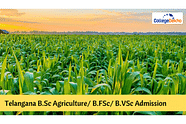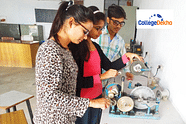COMEDK UGET 2025 Syllabus is likely to be released in the first week of February 2025 along with the official notification brochure. The syllabus of COMEDK UGET 2025 comprises Physics, Chemistry, and Mathematics subjects.
- COMEDK UGET 2025 Syllabus
- COMEDK UGET 2025 Syllabus Overview
- COMEDK UGET 2025 Syllabus Official Website
- Will There Be Changes in COMEDK UGET Syllabus 2025?
- COMEDK UGET Syllabus 2025 List
- COMEDK UGET 2025 Syllabus for Physics
- COMEDK UGET 2025 Syllabus for Chemistry
- COMEDK UGET Syllabus 2025 Mathematics
- Subject-Wise COMEDK UGET Syllabus PDF 2025
- COMEDK UGET 2025 Important Chapters
- Faqs

COMEDK UGET 2025 Syllabus:
The Consortium of Medical, Engineering, and Dental Colleges of Karnataka will issue the COMEDK UGET 2025 syllabus PDF in the first week of February 2025. The syllabus of COMEDK 2025 will comprise 3 main subjects; Physics, Chemistry, and Mathematics. It is expected that the COMEDK UGET syllabus 2025 will not change and be as per the previous year's syllabus only. The COMEDK UGET syllabus is as per the CBSE class 11 and 12th syllabus, so NCERT is the best study resource for COMEDK aspirants. While preparing for the COMEDK 2025, candidates must study the complete syllabus and focus on high-weight topics. Applicants can check out the detailed COMEDK UGET syllabus 2025 on this page.
Also Check -
COMEDK UGET 2025: Application Form, Exam Dates, Eligibility, Pattern, Syllabus, Preparation Tips
COMEDK UGET 2025 Syllabus
Consortium of Medical, Engineering, and Dental Colleges of Karnataka will be releasing the COMEDK UGET 2025 syllabus on its official website at www.comedk.org. The COMEDK syllabus 2025 includes 3 main subjects namely Physics, Chemistry, and Mathematics. Each section carries 60 questions of one mark. The questions in the COMEDK examination will be asked from the chapters and topics of the syllabus. The COMEDK UGET syllabus is as per the CBSE Class 11 and 12th syllabus.
COMEDK UGET 2025 Syllabus Overview
COMEDK UGET 2025 syllabus will be released along with the official notification brochure. The syllabus of COMEDK UGET 2024 will include subjects, topics, and sub-topics that candidates need to study for the exam. The COMEDK UGET syllabus PDF 2024 will be published online. Candidates get highlights about the COMEDK syllabus 2025 below.
Particulars | Details |
|---|---|
Name of the Exam | COMEDK UGET 2025 |
COMEDK UGET Full Form | Consortium of Medical, Engineering, and Dental Colleges of Karnataka |
Conducting Body | Consortium of Medical, Engineering, and Dental Colleges of Karnataka (COMEDK) |
COMEDK UGET 2025 Exam Date | Second Week of May 2025 |
COMEDK UGET 2025 Syllabus PDF Release Date | First Week of February 2025 |
COMEDK UGET Syllabus 2025 PDF Release Mode | Online |
Total Number of Sections in COMEDK UGET 2025 Syllabus | 3 Sections –
|
COMEDK UGET 2025 Syllabus Official Website | www.comedk.org |
COMEDK UGET 2025 Syllabus Official Website
The COMEDK UGET syllabus 2025 official website link is www.comedk.org. The authorities release the COMEDK syllabus only in online mode. There is no offline availability of the COMEDK UGET syllabus. While preparing for the COMEDK exam, candidates should refer to the official syllabus only as questions will be framed from within it. It is expected that the COMEDK syllabus will be published in the first week of February 2025.
www.comedk.org |
|---|
Will There Be Changes in COMEDK UGET Syllabus 2025?
The syllabus of COMEDK UGET does not change usually. It remains the same over the years and includes the same 3 subjects Physics, Chemistry, and Mathematics. As the COMEDK UGET 2025 syllabus will be aligned with the CBSE class 11 and 12th syllabus, if the CBSE board brings any changes in its syllabus it will be reflected on the COMEDK syllabus too.
However, the COMEDK UGET 2025 syllabus is likely not to be changed.
COMEDK UGET Syllabus 2025 List
A total number of 180 questions will be asked from the COMEDK UGET syllabus 2025. The syllabus of COMEDK is vast so candidates should begin their preparation early. There are 3 subjects included in the COMEDK syllabus. Candidates can check out the COMEDK UGET syllabus 2025 list below.
Subjects Name | Total Number of Questions | Section wise marks |
|---|---|---|
Physics | 60 | 60 |
Chemistry | 60 | 60 |
Mathematics | 60 | 60 |
Your Exam Blueprint!
COMEDK UGET 2025 Syllabus for Physics
COMEDK UGET Physics syllabus 2025 includes chapters like Gravitation, Work, Energy, and Power, Laws of Motion, Kinematics, etc. Candidates can check out the COMEDK UGET 2025 Physics syllabus below.Topics | Sub-Topics |
|---|---|
Units and Measurement | Need for measurement: Units of measurement; systems of units; SI units, fundamental and derived units. Length, mass and time measurements; accuracy and precision of measuring instruments; errors in measurement; significant figures |
Dimensions of physical quantities, dimensional analysis and its applications | |
Physical World | Physics-scope and excitement; nature of physical laws; Physics, technology and society |
Motion in a Straight Line | Frame of reference, Motion in a straight line: Position-time graph, speed and velocity |
Elementary concepts of differentiation and integration for describing motion. | |
Relations for uniformly accelerated motion (graphical treatment) | |
Uniform and non-uniform motion, average speed and instantaneous velocity. Uniformly accelerated motion, velocity-time and position-time graphs | |
Motion in a Plane | Scalar and vector quantities; Position and displacement vectors, equality of vectors, multiplication of vectors by a real number; addition and subtraction of vectors. Relative Velocity, Unit vector; Resolution of a vector in a plane - rectangular components. Scalar and vector product of vectors |
Motion in a plane. Cases of uniform velocity and uniform acceleration-projectile motion. Uniform circular motion | |
Laws of Motion | Intuitive concept of force. Inertia, Newton's first law of motion; momentum and Newton's second law of motion; impulse; Newton'sthird law of motion |
Law of conservation of linear momentum and its applications | |
Equilibrium of concurrent forces. Static and kinetic friction, laws of friction, rolling friction, lubrication | |
Dynamics of uniform circular motion: Centripetal force, examples of circular motion (vehicle on a level circular road, vehicle on banked road) | |
Work, Energy and Power | Work done by a constant force and a variable force; kinetic energy, work-energy theorem, power |
The notion of potential energy, the potential energy of a spring, conservative forces: conservation of mechanical energy (kinetic and potential energies); non-conservative forces: motion in a vertical circle, elastic and inelastic collisions in one and two dimensions | |
System of Particles and Rotational Motion | Centre of mass of a rigid body; centre of mass of a uniform rod |
Centre of mass of a two-particle system, momentum conservation and centre of mass motion | |
Moment of a force, torque, angular momentum, laws of conservation of angular momentum and its applications | |
Equilibrium of rigid bodies, rigid body rotation and equations of rotational motion, comparison of linear and rotational motions | |
Moment of inertia, radius of gyration. Values of moments of inertia, for simple geometrical objects (no derivation). Statement of parallel and perpendicular axes theorems and their applications | |
Gravitation | Acceleration due to gravity and its variation with altitude and depth |
Gravitational potential energy and gravitational potential. Escape velocity. Orbital velocity of a satellite. Geostationary satellites | |
Kepler'slaws of planetary motion. The universal law of gravitation | |
Mechanical Properties of Solids | Elastic behaviour, Stress-strain relationship, Hooke's law, Young's modulus, bulk modulus, shear modulus of rigidity, Poisson'sratio; elastic energy |
Mechanical Properties of Fluids | Pressure due to a fluid column; Pascal'slaw and its applications. (Hydraulic lift and hydraulic brakes), Effect of gravity on fluid pressure |
Surface energy and surface tension, angle of contact, excess of pressure across a curved surface, application of surface tension ideas to drops, bubbles and capillary rise | |
Viscosity, Stokes' law, terminal velocity, streamline and turbulent | |
Thermal Properties of Matter | Heat, temperature, thermal expansion; thermal expansion of solids, liquids and gases, anomalous expansion of water; specific heat capacity; Cp, Cv - calorimetry; change of state -latent heat capacity |
Heat transfer-conduction, convection and radiation, thermal conductivity, Qualitative ideas of Blackbody radiation, Wein's displacement Law, Stefan'slaw, Greenhouse effect | |
Thermodynamics | The second law of thermodynamics: reversible and irreversible processes. Heat engine and refrigerator |
Thermal equilibrium and definition of temperature (zeroth law of thermodynamics). Heat, work and internal energy. The first law of thermodynamics. Isothermal and adiabatic processes | |
Oscillations | Periodic motion - time period, frequency, displacement as a function of time. Periodic functions |
Free, forced and damped oscillations(qualitative ideas only), resonance | |
Simple harmonic motion (S.H.M) and its equation; phase; oscillations of a loaded spring-restoring force and force constant; energy in S.H.M. Kinetic and potential energies; simple pendulum derivation of expression for its time period | |
Kinetic Theory | Equation of state of a perfect gas, work done in compressing a gas Kinetic theory of gases - assumptions, concept of pressure. Kinetic interpretation of temperature; rms speed of gas molecules; degrees of freedom, law of equipartition of energy (statement only) and application to specific heat capacities of gases; concept of mean free path, Avogadro's number |
Electric Charges and Fields | Electric Charges; Conservation of charge, Coulomb’s law force between two point charges, forces between multiple charges; superposition principle and continuous charge distribution |
Electric field, electric field due to a point charge, electric field lines, electric dipole, electric field due to a dipole, torque on a dipole in uniform electric field | |
Electric flux, statement of Gauss’s theorem and its applications to find field due to infinitely long straight wire, uniformly charged infinite plane sheet and uniformly charged thin spherical shell (field inside and outside). | |
Electrostatic Potential and Capacitance | Electric potential, potential difference, electric potential due to a point charge, a dipole and system of charges; equipotential surfaces, electrical potential energy of a system of two point charges and of electric dipole in an electrostatic field |
Conductors and insulators, free charges and bound charges inside a conductor. Dielectrics and electric polarisation, capacitors and capacitance, combination of capacitors in series and in parallel, capacitance of a parallel plate capacitor with and without dielectric medium between the plates, energy stored in a capacitor. (no derivation, formulae only) | |
Waves | Wave motion. Transverse and longitudinal waves, speed of wave motion. Displacement relation for a progressive wave. Principle of superposition of waves, reflection of waves, standing waves in strings and organ pipes, fundamental mode and harmonics, Beats, Doppler effect |
Current Electricity | Electric current, flow of electric charges in a metallic conductor, drift velocity, mobility and their relation with electric current; Ohm’s law, V-I characteristics (linear and non-linear), electrical energy and power, electrical resistivity and conductivity, temperature dependence of resistance |
The internal resistance of a cell, potential difference and emf of a cell, and combination of cells in series and in parallel. Kirchhoff’slaws, Wheatstone bridge | |
Moving Charges and Magnetism | Biot - Savart law and its application to the current carrying circular loop |
Concept of the magnetic field, Oersted’s experiment | |
Ampere’s law and its applications to infinitely long straight wire. Straight solenoid (only qualitative treatment), Force on a moving charge in uniform magnetic and electric fields | |
Force on a current-carrying conductor in a uniform magnetic field. The force between two parallel current-carrying conductors- definition of ampere. Torque experienced by a current loop in a uniform magnetic field; Current loop as a magnetic dipole and its magnetic dipole moment. moving coil galvanometer current sensitivity. and conversion to ammeter and voltmeter | |
Magnetism and Matter | Bar magnet, bar magnet as an equivalent solenoid, (qualitative treatment only) Magnetic field intensity due to a magnetic dipole (bar magnet) along its axis and perpendicular to its axis. (qualitative treatment only), Torque on a magnetic dipole (bar magnet) in a uniform magnetic field; (qualitative treatment only), magnetic field lines |
Magnetization of materials, the effect of temperature on magnetic properties
| |
Magnetic properties of materials-, dia- and ferromagnetic substances, with examples | |
Alternating Current | Alternating currents, peak and rms value of alternating current/voltage; reactance and impedance; LCR series circuit, (phasors only), resonance; power in AC circuits, wattless current |
AC generator and transformer | |
Basic idea of displacement current. Electromagnetic waves and their characteristics Transverse nature of electromagnetic waves. (Qualitative ideas only) | |
Electromagnetic Waves | Electromagnetic spectrum (radio waves, microwaves, infrared, visible, ultraviolet, X-rays, gamma rays) including elementary facts about their uses |
Ray Optics and Optical Instruments | Ray Optics |
Reflection of light, spherical mirrors, mirror formula. Refraction of light, total internal reflection and optical fibers, refraction at spherical surfaces, lenses, thin lens formula, lensmaker’s formula. Magnification, power of a lens, combination of thin lenses in contact.. Refraction of light through a prism | |
Optical instruments: Microscopes and astronomical telescopes (reflecting and refracting) and their magnifying powers | |
Electromagnetic Induction | Electromagnetic induction; Faraday’s laws, induced emf and current; Lenz’s Law, Self and mutual induction |
Wave Optics | Wave optics: Wave front and Huygen's principle, reflection and refraction of plane wave at a plane surface using wave fronts. Proof of laws of reflection and refraction using Huygens principle. Interference Young's double slit experiment and expression for fringe width, (No derivation final expression only) coherent sources and sustained interference of light. Diffraction due to a single slit, width of central maximum, (qualitative treatment only) |
Dual Nature of Radiation and Matter | Dual nature of radiation. Photoelectric effect, Hertz and Lenard's observations; Einstein’s photoelectric equation-particle nature of light. Experimental study of the photoelectric effect |
Matter waves-wave nature of particles, de Broglie relation | |
Nuclei |
|
Composition and size of nucleus, nuclear force | |
Semiconductor Electronics: Materials, Devices and Simple Circuits | Energy bands in solids conductors, insulator and semiconductors; (Qualitative ideas only) ) Intrinsic and extrinsic semiconductors- p and n type, p-n junction Semiconductor diode– I-V characteristics in forward and reverse bias, application of junction diode - diode as a rectifier |
Atoms | Alpha-particle scattering experiment; Rutherford’s model of atom; Bohr model, of the hydrogen atom, Expression for the radius of the nth possible orbit, velocity and energy of an electron in this orbit, hydrogen line spectra (qualitative treatment only |
Also Check - COMEDK UGET 2025 Exam Dates: Application Form, Admit Card, Result Date
COMEDK UGET 2025 Syllabus for Chemistry
The COMEDK UGET 2025 Chemistry syllabus includes topics like Chemical Bonding, Atomic Structure, Surface Chemistry, Solid State, etc. Candidates can check out the COMEDK UGET Chemistry syllabus 2025.Topics | Sub-Topics |
|---|---|
Thermodynamics | Thermodynamic Terms, Thermodynamic Quantities, First Law of Thermodynamics, Thermochemistry, Spontaneity, Third Law of Thermodynamics. |
Chemical Bonding | Types of Chemical Bonds, Valence Bond Theory, Molecular Orbital Theory, Hydrogen Bond. |
Atomic Structure | Introduction to Structure of Atom, Atomic models, Shapes of Atomic Orbitals, Rules for Filling Electrons in Orbitals, Quantum Mechanical Model, Stability of Completely Filled and half-filled Orbitals. |
Solid State | Introduction to Solid State Chemistry, Classification of Solids on the Basis of Order in the Arrangement, Crystal Lattices and Unit Cells, Close Packing in Solids, Imperfections in Solids, Electrical Properties, Magnetic Properties |
States of Matter: Gases and Liquids | Intermolecular Forces, Laws Governing Gaseous State, Ideal Behaviour, Deviation from Ideal Behaviour, Liquefaction of Gases, Liquid State |
Redox reactions and Electrochemistry | Oxidation and Reduction Reactions, Types of Redox Reactions, Types of Redox Reactions, Redox Reactions in Terms of Electron Transfer Reactions, Oxidation Number, Balancing of Redox Reactions, Types of Electrochemical Cells, Electrolysis, Conductance in Electrolytic Solutions, Corrosion |
Chemical Equilibrium | Introduction to Equilibrium, Equilibrium in Physical Processes, Equilibrium in Chemical Processes, Types of Chemical Equilibria, Applications, of Equilibrium Constant, Factors Affecting Equilibria, Ionic Equilibrium in Solution, Ionization of Acids and Bases, Buffer Solutions, Solubility Equilibria of Sparingly, Soluble Salts |
Solutions | Introduction to solutions, Classification of Liquid-Liquid Solutions on the basis of Raoult’s Law, Solubility, Vapour Pressure of Liquid Solutions, Colligative Properties, Types of Solutions, Expressing the Concentration of Solutions of Solids in Liquids, Abnormal Molecular Mass. |
Solid State | Introduction to Solid State Chemistry, Classification of Solids on the Basis of Order in the Arrangement, Crystal Lattices and Unit Cells, Close Packing in Solids, Imperfections in Solids, Electrical Properties, Magnetic Properties. |
d and f - Block Elements and Coordination Compounds | d-Block elements, F-Block Elements, Coordination Compounds, IUPAC Nomenclature of Coordination Compounds, Valence Bond Theory as Applied to Coordination Compounds, Importance of Coordination Compounds |
Block & p-Block Elements and Metallurgy | S-Block Elements Group 1 Elements & Group 2 Elements, P-Block Elements Group 13, 14, 15, 16, 17 and 18 Elements |
Surface Chemistry | Catalysis, Colloids, Adsorption on a Surface |
Hydrocarbons, Haloalkanes, and Haloarenes | Types of Hybridization of Carbon, Classification of Organic Compounds, IUPAC Nomenclature of Organic Compounds, Stereochemistry and Isomerism, Homolytic and Heterolytic Fission of a Covalent Bond, Basics of Organic Reaction, Electronic Displacements in a Covalent Bond, Aromaticity, Alkanes (Upto 5 Carbon Atoms), Alkenes (Upto 5 Carbon Atoms), Alkynes (Upto 5 Carbon Atoms), Arenes, Haloalkanes and haloarenes. |
Chemical Kinetics | Rate of Chemical Reaction, Factors Affecting Rate of a Reaction, Integrated Rate Equations and Half Life, Temperature Dependence of Rate of Reaction, Collision Theory |
Oxygen-containing Organic compounds | Structure, Preparation of Alcohols and Phenols, Properties of Alcohols, Phenols and Ethers, Preparation of Ethers & Chemical Properties, Physical, Chemical Properties and Uses of Aldehydes and Ketones, Carboxylic acids. |
Nitrogen-containing Organic compounds | Structure, Preparation of Amines, Physical and Chemical Properties of Amines, Diazonium Salts. |
Environmental Chemistry | Pollution, Water Pollution, Environmental, Industrial Pollution |
Bio-Molecules and Polymers | Polymers, Biomolecules |
Chemistry in everyday life | Chemicals in Medicines, Food, and Hygiene (Soaps and Detergents) |
COMEDK UGET Syllabus 2025 Mathematics
Candidates can check out the COMEDK UGET 2025 Mathematics syllabus below.Topics | Sub-Topics |
|---|---|
Trigonometric Functions | Positive and negative angles. Definition of trigonometric functions with the help of unit circle. Truth of the identity cos2 x + sin2 x = 1, for all x. Signs of trigonometric functions. Measuring angles in radians and in degrees and conversion from one measure to another. Domain and range of trigonometric functions and their graphs. Expressing sin (x±y) and cos (x±y) in terms of sinx, siny, cosx & cosy and their simple applications |
Relations and Functions | Ordered pairs. Pictorial representation of a function, domain, co-domain, and range of a function. Cartesian product of the set of reals with itself. Definition of relation, pictorial diagrams, domain, co-domain, and range of a relation. Cartesian product of sets. Number of elements in the Cartesian product of two finitesets. Function as a special type of relation. Real valued functions, domain and range of these functions, constant, identity, polynomial, rational, modulus, signum, exponential, logarithmic, and greatest integer functions, with their graphs |
Sets | Sets and their representations, Empty set, Finite and Infinite sets, Equal sets, Subsets. Subsets of a set of real numbers especially intervals (with notations). Power set. Universalset. Venn diagrams. Union and Intersection of sets |
Linear Inequalities | Algebraic solutions of linear inequalities in one variable and their representation on the number line. Graphical method of finding a solution of a system of linear inequalities in two variables. Graphical solution of linear inequalities in two variables. |
Complex numbers and Quadratic Equations | Need for complex numbers, especially √−1, to be motivated by inability to solve some of the quadratic equations. Statement of Fundamental Theorem of Algebra, solution of quadratic equations (with real coefficients) in the complex number system. Algebraic properties of complex numbers. |
Straight Lines | Brief recall of two dimensional geometry from earlier classes. Various forms of equations of a line: parallel to axis, point -slope form, slope-intercept form, two-point form,intercept form and normal form. General equation of a line. Distance of a point from a line. Slope of a line and angle between two lines. |
Permutations and Combinations | Fundamental principle of counting. Factorial n. (n!) Permutations and combinations, simple applications |
Sequence and Series | Arithmetic Progression (A. P.). Arithmetic Mean (A.M.) Geometric Progression (G.P.), general term of a G.P., sum of n terms of a G.P., infinite G.P. and its sum, geometric mean (G.M.), relation between A.M. and G.M |
Statistics | Measures of Dispersion: Range, mean deviation, variance, and standard deviation of ungrouped/grouped data |
Conic Sections | Sections of a cone: circles, ellipse, parabola, hyperbola. Standard equations and simple properties of parabola, ellipse and hyperbola. Standard equation of a circle |
Limits and Derivatives | Derivative introduced as rate of change both as that of distance function and geometrically. The definition of derivative relate it to scope of tangent of the curve, derivative of sum, difference, product and quotient of functions. Limits of polynomials and rational functions trigonometric, exponential and logarithmic functions. Derivatives of polynomial and trigonometric functions. Intuitive idea of limit. |
Relations and Functions | Types of relations: reflexive, symmetric, transitive and equivalence relations. One to one and onto functions |
Probability | Random experiments: outcomes, sample spaces (set representation). Events: occurrence of events, ‘not’, ‘and’ and ‘or’ events, exhaustive events, mutually exclusive events. Probability of an event, probability of ‘not’, ‘and’ and ‘or’ events |
Matrices | Concept, notation, order, equality, types of matrices, zero and identity matrix, transpose of a matrix, symmetric and skew symmetric matrices. Operation on matrices: Addition and multiplication and multiplication with a scalar. On- commutativity of multiplication of matrices and existence of non-zero matrices whose product is the zero matrix (restrict to square matrices of order 2). Simple properties of addition, multiplication and scalar multiplication. Invertible matrices and proof of the uniqueness of inverse, if it exists; (Here all matrices will have real entries) |
Inverse Trigonometric Functions | Definition, range, domain, principal value branch. Graphs of inverse trigonometric functions |
Linear Programming | Introduction, related terminology such as constraints, objective function, optimization, graphical method of solution for problems in two variables, feasible and infeasible regions (bounded or unbounded), feasible and infeasible solutions, optimal feasible solutions (up to three non-trivial constraints) |
Determinants | Determinant of a square matrix (up to 3 x 3 matrices), minors, co-factors and applications of determinants in finding the area of a triangle. Adjoint and inverse of a square matrix. Consistency, inconsistency and number of solutions of system of linear equations by examples, solving system of linear equations in two or three variables (having unique solution) using the inverse of a matrix |
Continuity and Differentiability | Continuity and differentiability, chain rule, derivative of inverse trigonometric functions like sin−1, cos−1 and tan−1, Derivative of implicit functions. Concept of exponential & logarithmic functions. Derivatives of logarithmic and exponential functions. Logarithmic differentiation, Derivatives of functions expressed in parametric forms. Second order derivatives |
Applications of Derivatives | Applications of derivatives: rate of change of bodies, increasing/decreasing functions, maxima and minima (first derivative test motivated geometrically and second derivative test given as a provable tool). Simple problems (that illustrate basic principles and understanding of the subject as well as real-life situations) |
Integrals | Integration is the inverse process of differentiation. Integration of a variety of functions by substitution, partial fractions and parts |
Applications of Integrals | Applications in finding the area under simple curves, especially lines, circles/ parabolas/ellipses (in standard form only) |
Differential Equations | Solution of differential equations by method of separation of variables, solutions of homogeneous differential equations of first order and first degree. Definition, order and degree, general and particular solutions of a differential equation. |
Probability | Conditional probability, multiplication theorem on probability, independent events, total probability, Bayes’ theorem, Random variable and its probability distribution, mean of random variable |
Three- Dimensional Geometry | The angle between two lines. Direction cosines and direction ratios of a line joining two points. Cartesian equation and vector equation of a line, skew lines, shortest distance between two lines. |
Vectors | Vectors and scalars, magnitude and direction of a vector. Direction cosines and direction ratios of a vector. Types of vectors (equal, unit, zero, parallel and collinear vectors), position vector of a point, negative of a vector, components of a vector, addition of vectors, multiplication of a vector by a scalar, position vector of a point dividing a line segment in a given ratio. Definition, Geometrical Interpretation, properties and application of scalar (dot) product of vectors, vector (cross) product of vectors |
Subject-Wise COMEDK UGET Syllabus PDF 2025
The COMEDK UGET 2025 syllabus PDF is likely to be released in the first week of February 2025 along with the official notification brochure. However, till the COMEDK UGET syllabus 2025 PDF is published, candidates can check out the previous year's syllabus. It is expected that the COMEDK UGET 2025 syllabus will be as per the previous year's syllabus only. So, candidates who are starting their COMEDK preparation now can study from this previous year’s syllabus only instead of waiting till February 2025.
Subject Name | COMEDK UGET Syllabus PDF Download |
|---|---|
COMEDK UGET Mathematics Syllabus PDF | |
COMEDK UGET Physics Syllabus PDF | |
COMEDK UGET Chemistry Syllabus PDF |
COMEDK UGET 2025 Important Chapters
The vast syllabus of COMEDK UGET 2025 includes certain important chapters. These chapters of the COMEDK syllabus have carried a good amount of weightage in the previous year and several questions were asked from it. Candidates studying the COMEDK UGET syllabus 2025 should focus on these important chapters to score good marks in the exam.
Check the list of important COMEDK UGET 2025 chapters below.
Subject | COMEDK UGET Important Chapters |
|---|---|
Physics |
|
Chemistry |
|
Mathematics |
|
Related Articles
We hope that this post on the COMEDK UGET 2025 syllabus was helpful and informative. For more information about COMEDK UGET 2025, stay tuned to CollegeDekho.
Are you feeling lost and unsure about what career path to take after completing 12th standard?
Say goodbye to confusion and hello to a bright future!

FAQs
No, COMEDK is not only class 12th syllabus. COMEDK UGET 2025 syllabus is as per the Class 11 and 12th syllabus.
The subjects like Physics, Chemistry, and Mathematics are included in the COMEDK UGET 2025 syllabus.
It is highly unlikely that the COMEDK UGET syllabus 2025 will not be changed and remain as it is.
The COMEDK UGET 2025 syllabus is expected to be released in the first week of February 2025 in online mode.
Was this article helpful?


















Similar Articles
Polytechnic Courses 2025: Details, Fees, Eligibility, Admission Criteria
TS POLYCET 2025 (May 13): Hall Ticket, Pattern, Preparation, Result
AP ECET 2025: Exam Date, Syllabus, Eligibility, Exam Pattern
TS EAMCET 2025: Result (Out), Exam Dates (April 29 to May 4), Eligibility, Pattern, Preparation
TS EAMCET 2025 Exam Date (May 2 to 4): Result (Out), Counselling (Soon)
COMEDK UGET 2025 Exam Dates: Admit Card, Exam (Shift 2 Over), Result Date, Counselling